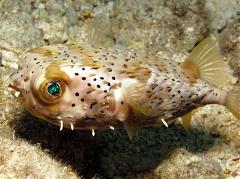Facts and Information

The Porcupinefish, aka the Porcupine Pufferfish is eternally popular with marine hobbyists for its ease of care and personable nature. This species can be quite gluttonous and will eat to the point the belly distends. Generally a very healthy specimen that rarely develops the run-of-the-mill aquarium illnesses, save for the ever-present skin parasites, "ick", and "velvet" aka Oodinium. Fortunately, they respond quite well to freshwater "dips" or manipulations of the specific gravity level in the tank. In stubborn cases, copper treatments work wonders for infestations of various skin parasites. Porcupine Puffers can grow quite large (to thirty inches) and are usually long-lived in the aquarium. The body is covered with long spines that become erect when the fish inflates (hence it’s other popular name, the Blowfish) itself during periods of pursuit or capture (used for defense) that can inflict painful wounds to the hapless aquarist. In the wild, Porcupinefish spend their time foraging for mollusks (clams, bi-valves, oysters, etc), shrimp, crabs (a particular favorite), and sea urchins. Even hermit crabs are not safe from the crushing beak-like teeth of this fish and are readily eaten. Shell-on type foods are a requirement in keeping the ever-growing teeth of this fish ground down to a manageable level. Live crustacean foods are highly relished and readily available in the form of ghost shrimp, crayfish (aka crawdads) and mangrove fiddler crabs (aka "mini-crabs"). Frozen meaty-type foods are readily accepted, as are freeze dried types like krill. Small live or frozen fish are also greedily eaten.
Size - Jumbo
Possible Tankmates - Sea Betta, Emperor Angelfish, Red Sea Heniochus